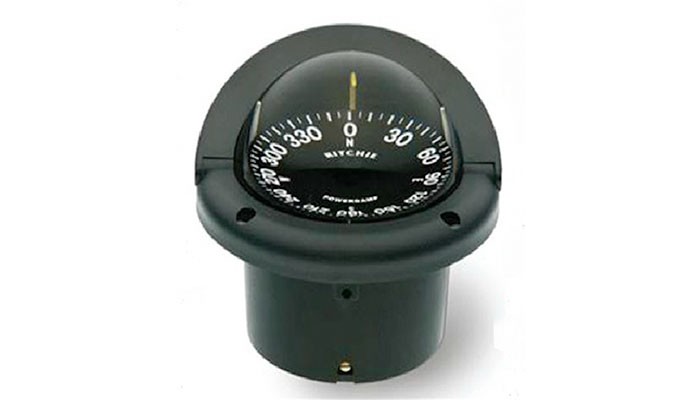By Bill Jennings
from 28-1
In this day of Smart Phones, GPS plotters and the myriad of available electronic navigational tools and aids, we can easily forget about the good old compass. This is a big mistake!
A compass is the basic building block for every boat navigation system. Its operation is very simple. It measures direction in frames of reference to north, south, east and west relative to the surface of the earth. A diagram, or compass rose on the face of the compass, provides directions in degrees relative to north. These degree numbers allow the compass to show us azimuths or bearings. While there are different types of compasses, they are all designed to deliver the same degrees of reference information.
The “magnetic compass” contains a magnet that interacts with the earth’s magnetic field and aligns to point to the earth’s magnetic poles. The common liquid magnetic compass encases a fluid to dampen the magnetized needle or card and prevent excessive swing which can be caused by your boat’s movements. This improves readability and reduces wear.
A “gyrocompass” contains one or more rapidly spinning wheels, or gyros, whose rotation interacts dynamically with the rotation of the earth so as to make the wheel precise, losing energy to friction until its axis of rotation is parallel with the earths.
A “fluxgate” compass employs two or more coils of wire around a core of highly magnetic material, to directly sense the direction of the horizontal component of the magnetic field of the earth. A fluxgate compass has no moving parts and its readings are electronic, so can be easily transmitted to a digital read out or autopilot.
All piloting courses teach the difference between true and magnetic headings and show you how to plot on your nautical chart the headings between waypoints and how to use your compass to follow them. Even if you use a GPS to set and monitor your course, a compass will serve as an essential backup device and will work when all else fails.
When purchasing a compass, there are several things you need to remember. In general, the larger the compass, the better the accuracy, stability and readability. Look for a recognised brand name and don’t be tempted to buy one based on a cheap price. Test the compass before buying by moving a magnet or heavy metal object back and forth beside the compass. When the magnet or metal is removed, the card should return smoothly to its original position without oscillating excessively.
Choose a compass that is designed to work on your type of boat. A sailboat compass may require a gimballed mounting, while a powerboat compass needs to be mounted far enough from electrical instruments to avoid interference that will cause ‘deviation’. Be sure your compass is mounted in your line of sight for easier and more accurate reading.
Here are some practical tips that illustrate the usefulness of a compass in everyday recreational boating:
1) If you boat on small lakes, chances are you travel on similar course directions on a regular basis. Jot down on a piece of paper, the compass heading for two or three of the main legs that you travel and place the information in your glove box. Now you are prepared for that dark night, the faulty GPS or the thunderstorm. Simply take out the paper and use the headings you noted as reference and confirmation that the direction you are heading is correct.
2) You come across a single red lateral day marker in open water and are not be sure on which side you are to pass. Your compass heading will give you your direction and your chart will tell you whether that direction is upstream or downstream. (If upstream, keep the red marker on your right.)
3) When telling friends how to find your cottage by boat, give them a magnetic compass heading from a nearby landmark, or navigational marker out on the water.
Have fun with this – see how many compass applications you and your crew can discover – and add a note to your spring pre-launch list to check the functionality of the compass on your boat.

